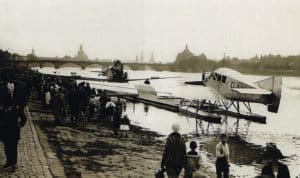This site is available in multiple languages: Deutsch, Русский, عربي.
Following Arnoldstraße toward the Elbe, you will reach location 6 of the historical walking tour: Thomas-Müntzer-Platz.
Before 1945: Field marshalls, floods and flight

Feldherrenplatz
The area now known as Thomas-Müntzer-Platz first came to be in 1904, under the name Feldherrenplatz (General Square). Its name referred to the bordering street, Feldherrenstraße (today Florian-Geyer-Straße). It is possible that the name was given in honor of then Crown Prince—later King—Albert’s appointment to General Field Marshall in 1871. The space remained undeveloped until about 1912. After 1912, buildings at number 3, 4 and 5 sprang up one right after the other. They were constructed by Striesen master carpenter and building firm owner, Max Albin Förster. Three years later came houses number 6 and 7, by surveyor Hans Gentsch and the building industry’s Friedrich E. Hermann. From 1915 onward, the office of the 25th police precinct was located in house no. 1. The new houses were primarily occupied by well-to-do citizens of Dresden, including court actors, art dealers, engineers, a bank officer, a factory owner and a city building inspector.
Antons Bäder
Antons Bäder (Anton’s baths) on the Elbe, not far from the Fährgarten (ferry grounds), became a beloved local spot for swimming and excursions. The elected chief river inspector, Christian Gottlob Anton, acquired the plot of land in 1754, which had previously been home to a lime kiln. He received permission to both construct a house with a garden and to run an inn with a distillery, bakery and butcher shop. His building was based on the rococo style of French country house. In 1922, the city of Dresden built a light and air bath on the property. The bombs that fell on Dresden in 1945 destroyed Antons Bäder. Today, all that is left to mark the former baths is a hedge growing next the Elbe.
Find more information on the history of Antons Bäder here.
|
|
|
The Dresden hydroplane port
Dresden, 1925. A first in Europe: the establishment of a hydroplane route along the Elbe between Dresden-Johannstadt and Altona bei Hamburg, with a stopover in Magdeburg, through Junkers Luftverkehr AG. The company aimed to set up regular air travel on the Elbe with Junkers F13 hydroplanes, initially for three months. For flight check-in, they used the rowing club building, still standing and converted into the restaurant “Johann” in 2020. To the cheers of an excited public, the first plane took off from the banks of Johannstadt on August 10, 1925, near what was once Gneisenaustraße (today Bundschuhstraße). Just one year later, the hydroplane route had proved to be uneconomical: 1926, the line ceased operations at fall.
Find more information on the history of the hydroplane port here.
After 1945: Fährgarten and festivals

Feldherrenplatz becomes Thomas-Müntzer-Platz
Unlike a large portion of its surroundings, Feldherrenplatz survived the aerial attack of 1946 without any large structural losses. After 1945, one arm of the rubble rail ran across the space. This railway was used until around the middle of the 1950s to transport rubble from the ruins of Johannstadt to the fields along the Elbe (Elbwiesen). Starting in 1946, numerous streets in north Johannstadt received names relating to the peasant’s revolt, e.g. Bundschuhstraße, Pfeifferhannsstraße and Florian-Geyer-Straße. In the same vein, Feldherrenplatz received the name of the leader of the peasant’s revolt, Thomas Müntzer.
Elbwiesen after 1945
After the end of the war, large swaths of the Johannstädter Elbwiesen—from around Neubertstraße to Schubertstraße—were piled up with rubble. As a consequence, the fields’ elevation increased dramatically. A collection of the rubble which came to light during the construction of a car park at Waldschlößchen bridge in 2007 could be seen on display in the “Wohnkultur” exhibition in the JohannStadthalle until 2023. After the ruins were removed in 1958, the area of “Antons Bäder” was used initially for an allotment garden, named Elbfrieden II. Plans to build an international campground in the 1970s could never be implemented because the area was situated within a flood zone. The Elbwiesen (Elbe fields) are used today as a local recreation area, as well as an event site.
Johannstädter Festspiele and Elbefest
The Johannstädter Festspiele on the Elbwiesen first took place in 1972, at the initiative of the Stadtbezirk Dresden-Mitte. The three-day event was conceived as a folk festival and offered entertainment for young and old, including a concert with Nina Hagen in 1975. In 1983, 70,000 visitors were in attendance, consuming 7,000 liters of beer and 12,600 fish buns at the Konsum “steamboat-stand”. The Johannstädter Festspiele took place 14 times, right up until the end of the GDR: the final event was held from September 8th to 10th, 1989. In 2001, the tradition of was revived by the Wohnungsgenossenschaft Johannstadt (WGJ) as the yearly Johannstädter Elbefest.

|
|
|
Johannstädter Elbeschwimmen
On August 15, 1998, almost 100 volunteers answered the call of then head councilman, Dr. Dietrich Ewers (1939-2018), and plunged into the not yet quite clean waters of the Elbe (quality grade 2) at the Blaues Wunder for the first Elbeschwimmen. Three kilometers downstream they received a free drink and a bratwurst at Fährgarten Johannstadt. In 2018, 1,789 people took part in the 20th Elbeschwimmen – a new record. Dr. Dietrich Ewers led the swim until 2016. Born in Magdeburg, he had lived at Thomas-Müntzer-Platz since 1965, and was an original Johannstädter. With the fall of the wall, the engineer entered politics, became a city councillor for the SPD and in 1990, took over the leadership of Altstadt local authority for the next 14 years. Besides the Elbeschwimmen, the Dresden Marathon e.V. and the Vietnamese Garden in Johannstadt were also created thanks to his efforts.
Find more information on the Johannstädter Elbeschwimmen here.

Text: Matthias Erfurth, Matthias Kunert, Henning Seidler
Editorial deadline: January 2024










